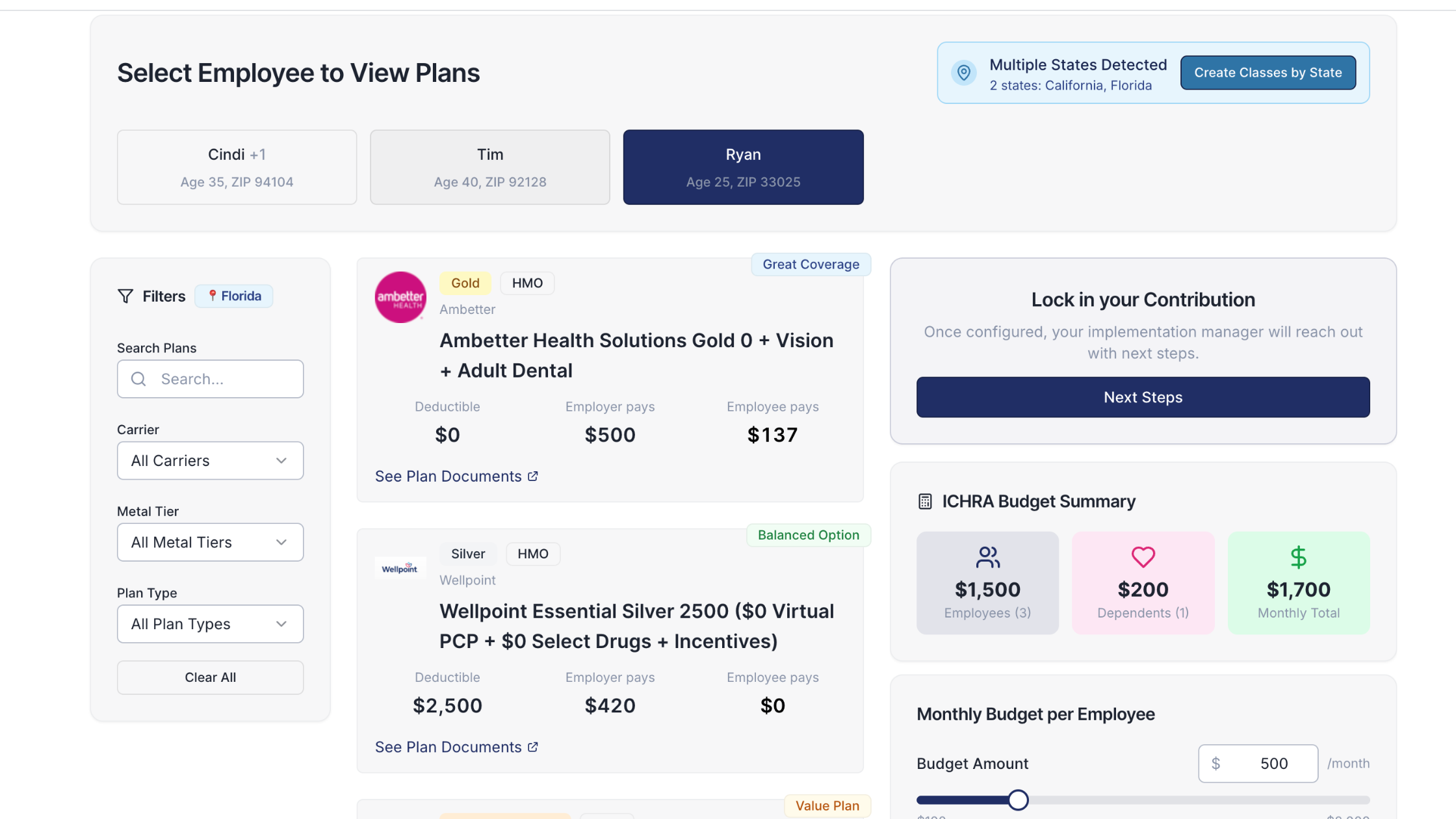Health Insurance Laws 2025: Federal Regulations and State-Specific Requirement

Choosing the right health insurance in 2025 isn't just about picking the best coverage—it's also about understanding new regulations. As federal and state rules continue to evolve, employers, benefits brokers, and HR leaders need clarity to stay compliant and deliver quality health benefits. In this article, we'll break down the latest health insurance laws for 2025, focusing on both federal regulations and state-specific requirements. You'll learn how these changes impact businesses, workers, and brokers, and how platforms like Venteur can help keep you ahead.
Overview of Health Insurance Laws 2025
Navigating health insurance regulations can feel overwhelming, with updates at both the federal and state level. The most significant changes for 2025 include:
- New eligibility rules and safeguards in the Affordable Care Act (ACA) Marketplace.
- Expanded state-specific mandates.
- Stricter compliance and reporting requirements for employers.
- Adjustments to special enrollment periods and affordability thresholds.
The key to compliance in 2025 is knowing how federal health insurance laws for employers intersect with state rules, while ensuring that your health plans meet both minimum federal standards and any additional state-based mandates.
Federal Health Insurance Laws and Regulations in 2025
What Are the Main Federal Regulations for 2025?
Federal requirements are primarily shaped by the ACA and ongoing Centers for Medicare & Medicaid Services (CMS) rulemaking.
Key elements of federal health insurance compliance for 2025 include:
- ACA Employer Mandate: Employers with 50 or more full-time equivalent employees must offer health coverage that is both “affordable” (costs less than 9.02% of household income) and provides “minimum value” (covers at least 60% of expected costs). Failing to do so can lead to penalties.
- Updated Marketplace Rules: CMS has finalized new standards for 2025 that strengthen income verification, eligibility redetermination, and deny eligibility for advance premium tax credits if prior year reporting is incomplete.
- Coverage for Adult Children: Employers must offer coverage to dependent children up to age 26, but not required to cover spouses.
- Open Enrollment Dates: For all federal and most state marketplaces, open enrollment runs from November 1 to January 15 for plans starting in 2025.
Penalties for Non-Compliance:
- If coverage isn't offered to at least 95% of full-time employees and their dependents, employers could face penalties starting at $362.50 per month per affected employee (for 2025).
Other Important Federal Healthcare Regulations
- Minimum Essential Coverage: Federal law no longer requires individuals to have coverage (no federal mandate penalty since 2019), but employer mandates remain.
- Essential Health Benefits (EHB): All ACA-compliant plans must cover a range of essential health benefits, including preventive services, maternity care, and mental health.
- Network Adequacy: Plans in both federal and state marketplaces must meet stricter standards ensuring provider access starting in 2025, with reviews required for certification.
- Retroactive Plan Termination: New federal rules allow for some retroactive cancellation of Marketplace plans (up to 6 months back) in cases like Medicare eligibility, to prevent double coverage and overpayment.
- Special Enrollment Period (SEP) Permanency: The expanded SEP for low-income applicants (<150% FPL) is now permanent, making it easier for more Americans to sign up year-round.
State-Specific Health Insurance Requirements in 2025
While federal laws form the foundation, state regulations can add extra layers of compliance. Understanding which states have individual mandates or unique rules is essential for nationwide employers or brokers.
Which States Have Their Own Health Insurance Mandates?
As of 2025, five states plus Washington D.C. enforce their own individual mandates and may levy penalties for not carrying Minimum Essential Coverage:
Most states (45 plus Vermont) do NOT have an individual mandate or penalty in 2025.
Additional State Employer Requirements
- Only Hawaii adds a stricter employer rule beyond the federal mandate: The Hawaii Prepaid Health Care Act requires most employees working 20+ hours per week to be offered coverage meeting state standards, which are stricter than the ACA.
Other State-Level Health Insurance Laws
- Penalties and Exemptions: Penalties for non-coverage are typically tied to income and may be capped at the cost of a bronze-tier plan. Common exemptions include financial or religious hardship and unaffordable plan options.
- ICHRA Compliance: Employers offering an Individual Coverage Health Reimbursement Arrangement (ICHRA) must follow both federal rules and any relevant state-level requirements. Venteur assists employers in all 50 states with this compliance.
- State-Specific Benefits or Coverage Rules: Some states (like Massachusetts) outline extra benefit requirements or reporting obligations for plans sold or administered in-state.
Major Regulatory Changes for 2025: What’s New and Why
Stricter Compliance for Employers
Federal health insurance laws for employers in 2025 zero in on two areas: affordability and reporting. Here’s what’s new:
- The affordability safe harbor for employer coverage is now 9.02% of employee household income (up from 8.39% in 2024).
- Penalties for lack of adequate, affordable coverage are indexed annually and continue to rise.
- The IRS maintains three affordability safe harbors: Federal Poverty Line, Rate of Pay, and W-2.
- New rules now require additional verification steps and eligibility confirmation in the ACA Marketplace for special enrollment and tax credits.
Enhanced Consumer Protections
- The CMS 2025 rule includes enhanced verification to reduce improper enrollments.
- Ongoing focus on transparency and accountability for premium costs and coverage options, especially in marketplaces.
- Regulatory changes are responding to rising healthcare costs, technological advances (like telehealth), and public health trends.
Network Adequacy and Enrollment Windows
- State-based exchanges must now align their open enrollment windows with the federal marketplace (Nov 1 – Jan 15), improving clarity for employers and employees.
- Inadequate provider networks are under higher scrutiny, and plans must justify if they can’t meet adequacy standards.
How Venteur Simplifies Health Insurance Compliance for Employers
Venteur stands out in the ICHRA (Individual Coverage Health Reimbursement Arrangement) marketplace, making regulatory compliance simple for brokers, employers, and HR leaders:
- Expert Support: Venteur’s team helps clients interpret and apply both federal and state compliance requirements in real time.
- Automated Compliance Checks: The Venteur platform integrates up-to-date legal rules for all 50 states, so employers don’t have to keep track of changes themselves.
- Cost Optimization: By leveraging ICHRA, Venteur helps companies lower costs and remain compliant, with no setup fees or minimums.
- Customizable Experience: Every company can tailor benefits while meeting minimum essential coverage, federal reporting, and any state mandates.
- Seamless Integration: Venteur’s system works with existing payroll and HR tools, supporting easy reporting and audit readiness.
State Spotlight: Recent and Unique State Health Insurance Laws
California, New Jersey, Massachusetts, Rhode Island, D.C.
Residents must carry qualifying health insurance or pay a penalty when filing state taxes, unless an exemption applies.
Vermont
Mandated coverage without a penalty—there’s a legal requirement, but no financial consequence (for now).
Hawaii
Employers face a stricter mandate than federal law. The Hawaii Prepaid Health Care Act means more employers must offer robust health benefits.
All Other States
No individual mandates or employer rules beyond the federal ACA requirements.
Final Thoughts
Navigating the health insurance laws in 2025 means staying ready for evolving federal and state rules. With new reporting and eligibility standards, rising affordability thresholds, and unique state mandates affecting a growing number of Americans, employers and brokers must stay nimble. By understanding both federal health insurance laws and state-specific requirements, organizations can avoid penalties and deliver better, more flexible benefits to their teams.
Working with platforms like Venteur simplifies health insurance compliance for all parties—from HR departments to independent brokers. With the right support, technology, and up-to-date information, you can keep your workforce protected and your business future-ready.
You got questions, we got answers!
We're here to help you make informed decisions on health insurance for you and your family. Check out our FAQs or contact us if you have any additional questions.
California, Massachusetts, New Jersey, Rhode Island, Vermont (no fine), and Washington D.C. have individual mandates. All other states do not.
The penalty for not offering affordable, minimum value coverage in 2025 is $362.50 per month per affected full-time employee, after the first 30 are excluded.
Employee-only coverage must cost less than 9.02% of employee household income to be considered affordable.
- Financial hardship
- Short coverage gaps
- Religious beliefs
- Lack of affordable coverage options (as defined by your state)
- Offer coverage to at least 95% of full-time employees and dependents
- Ensure plans cover at least 60% of expected costs
- Align open enrollment dates with federal/state rules
- Work with a platform like Venteur to track legal updates and avoid penalties
Explore more related content
What is Venteur
Explore the best human-first Health Insurance platform
Simple, personalized health benefits
Sign up in minutes, define your contribution, and let your employees choose the health plan that works right for them
Integrations to make everything run smoothly
We'll connect with your payroll and finance systems to make deductions and premium payments seamless
Easy onboarding and off-boarding
In just a few clicks, add your roster and make updates on the fly. We'll handle it from there.
Venteur Certified Brokers to help your employees pick the right plan
Our trusted brokers ensure the best outcomes for employees and employers by unlocking health savings and providing unrivaled plan options.
AI-powered plan recommendations to give you confidence while you shop
Backed by 30 years of healthcare data, Venteur’s AI helps employees compare and choose the best plan for their unique situation.
Compliance and reporting because no-duh!
Venteur manages plan administration, reporting, and compliance so you can focus on growing your business.


